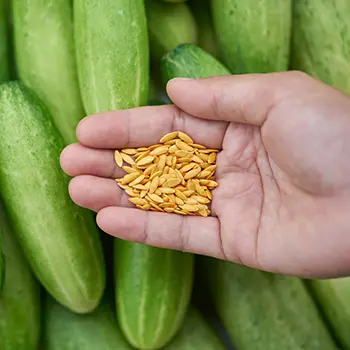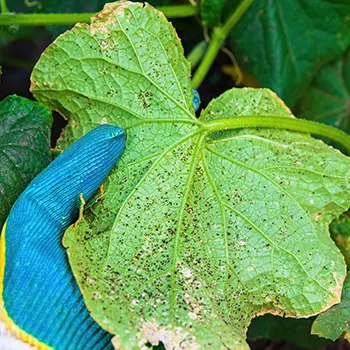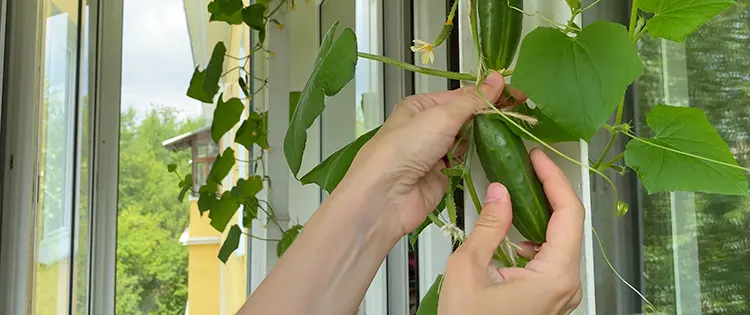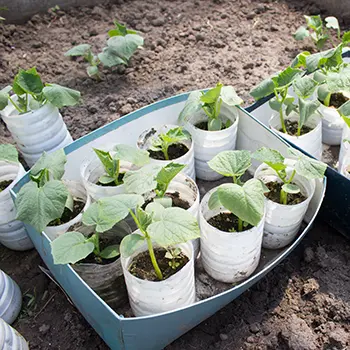There is nothing better than sinking your teeth into a crisp, fresh, tasting cucumber. They make awesome salads, pickles, drinks, and much more. You can buy cucumber seeds and plant your own, but can you plant the seeds from a grocery store-bought cucumber? Yes, you can, just not all of them. If you’ve just eaten some tasty store-bought cucumbers and want to recreate that refreshing taste, keep reading.
Plant Fully Ripe or Matured Seeds
The two types of cucumbers you can’t plant are the open-pollinated and the hybrid variety. It’s rare that hybrid types produce fruits when they’re re-planted. And the seeds from the open-pollinated variety have difficulties germinating. It’s also important to mention that you can’t plant seeds from cucumber scraps because cucumbers sold in the store are typically harvested before the seeds are fully matured or ripe. So basically, you can only plant fully ripe or matured seeds, here’s how.
How to Save Cucumber Seeds
Slice the cucumber in two lengthwise, scoop the pulp into a clear glass bowl and fill it with room temperature water. Soaking the seeds will get rid of the gel coating. Leave the bowl uncovered in a room between 70 and 80 degrees Fahrenheit. Stir the seeds once a day, and within three days some seeds will start sinking to the bottom of the bowl. This is a sign of fermentation and that the seeds are shedding their gel coating. The floating seeds are the poor seeds.
When most of the seeds have sunk, discard the floating seeds, use a sieve to strain the remaining water, and rinse the seeds. Put the seeds back into the bowl and add water, any remaining bad seeds will float to the top. Continue the process until all the seeds sink to the bottom.
Arrange some paper towels on a flat surface and leave the seeds on them to air dry. It will take approximately 48 hours to dry completely.
⇒ Click Here To Learn An Insanely Effective Way To Build A 5 Year Food Stockpile (Video)
How to Grow Store-Bought Cucumber Seeds
To start, you need to make sure the weather conditions are conducive to growing cucumbers. Summer is the best time of year when the weather is warm and moist. Like most vegetables, you can either grow cucumber seeds in a container or underground. Here are some step-by-step instructions.
Growing Cucumber Seeds in a Container
- Use a twenty-quart pot and add potting mix.
- Add the potting soil and plant 2-4 seeds one inch into the soil.
- Add fertilizer and water the seeds.
- The seeds will start germinating within 1-2 weeks.
- Don’t overwater the cucumbers, when the soil dries out, add just enough water to keep the soil moist.
Growing Cucumber Seeds Underground
- Get the soil ready by digging a 12-inch layer in your garden.
- Clear the area by removing large rocks, roots, stones, and dead plants.
- Add 3 inches of compost to the soil.
- Each bed should be 12 inches, each row should have a 16-inch space between it.
- Add 2-4 seeds to each hole and leave a space of 16-inches between each hole.
- Water the seeds as soon as you’ve planted them.
- Keep the soil moist at all times or the seeds won’t germinate.
- It should take 55-70 days after germination before the cucumbers are ready for harvesting.
How to Protect Your Growing Cucumbers
Whether you grow your cucumbers in a pot or in the ground, you will need to protect them while they grow, here are some tips:
Protection Against the Weather
Although you started growing your cucumbers during the summer months, the weather is unpredictable, and temperatures can sometimes drop below the required temperature for optimal growth. The good news is that you can protect your cucumbers from cold weather by growing them in a sheltered location. Avoid low, or exposed and open areas where cold air gathers. The best place to grow cucumbers is along shrubs, boulders, or fences. Pay attention to the weather forecast, and if there’s a forecast of cold weather, cover the cucumbers with a light material such as newspaper, plastic, or an old bed sheet.
Protection From Pests
There are several pests that if not kept under control will damage your cucumbers. The most effective method of protection is to use a floating row cover. Below is a list of pests to keep away from your cucumbers:
- Slugs and Snails: To stop slugs and snails chomping on your cucumbers, you can pick them by hand and dump them into a bucket of soapy water. Or, you can set up a beer trap. Slugs and snails like the smell of beer, so pour some beer into shallow bowls and leave them around the cucumber plants. The pests will crawl into the beer and drown.
- Spider Mites: Get rid of spider mites by spraying them with rotenone, insecticidal soap, or water.
- Cutworms: Cutworms chew on the leaves, stems, and roots of cucumber plants. Cutworms live just beneath the surface of the soil, to protect your cucumbers, place a cardboard collar around the plant’s stem. You can also sprinkle wood ash at the root of the plant. Additionally, make sure your garden is weed-free because cutworms love weeds.
- Leafhoppers: Leafhoppers attack cucumbers by sucking the juice out of the stems and leaves. To avoid this, spray the leaves with insecticidal soap.
- Aphids: Aphids reproduce quickly, and when they do, they’re difficult to control. As soon as they’re spotted, use insecticidal soap to treat the plant. You can also fill yellow pans with water, this will get their attention and drown them. Another trick is to plant cucumbers in a bed covered with aluminum foil.
- Cucumber Beetles: Cucumber beetles carry the disease of bacterial wilt in their bodies. When they munch on cucumber plants, they transfer the infection which ultimately kills the plant. To protect your plants against cucumber beetles, make sure your garden is free from weeds at the end of the growing season. You can also cover the cucumbers with a floating row cover.
Final Thought
There you have it, everything you need to know about growing grocery store cucumber seeds successfully.
⇒ Learn How To Get 295 Pounds Of Extra Food For Just $5 A Week (Video)
You may also like:
How to Grow Vegetables in Small Spaces
Dwarf Fruit Trees You Can Grow In A Tiny Space
Vegetable Independence – 100% Self-Reliant Vegetable Production















